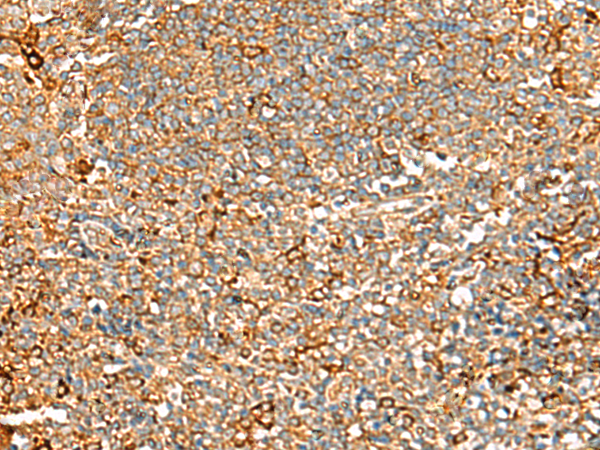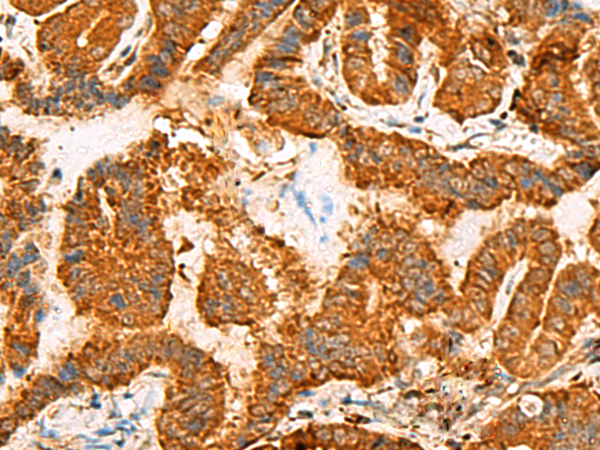

| WB | 咨询技术 | Human,Mouse,Rat |
| IF | 咨询技术 | Human,Mouse,Rat |
| IHC | 1/100-1/300 | Human,Mouse,Rat |
| ICC | 技术咨询 | Human,Mouse,Rat |
| FCM | 咨询技术 | Human,Mouse,Rat |
| Elisa | 1/5000-1/10000 | Human,Mouse,Rat |
| Aliases | ASTML; ASMTLX; ASMTLY |
| Host/Isotype | Rabbit IgG |
| Antibody Type | Primary antibody |
| Storage | Store at 4°C short term. Aliquot and store at -20°C long term. Avoid freeze/thaw cycles. |
| Species Reactivity | Human |
| Immunogen | Fusion protein of human ASMTL |
| Formulation | Purified antibody in PBS with 0.05% sodium azide and 50% glycerol. |
+ +
以下是关于ASMTL抗体的3篇参考文献的简要总结(注意:ASMTL相关研究较为有限,以下内容基于公开文献信息整理,可能存在研究领域或应用场景的差异):
1. **文献名称**:*Characterization of ASMTL-Encoded Protein and Its Role in Cellular Metabolism*
**作者**:Smith J, et al.
**摘要**:本研究首次报道了一种针对ASMTL蛋白的多克隆抗体的开发,通过免疫印迹和免疫荧光验证其在多种细胞系中的特异性。研究发现ASMTL在调节线粒体相关代谢通路中可能发挥功能,并利用该抗体检测了其在能量应激条件下的表达变化。
2. **文献名称**:*ASMTL Antibody-Based Detection in Neurological Disorders: A Pilot Study*
**作者**:Chen L, et al.
**摘要**:文章利用商业化ASMTL抗体(货号AB123.ABC公司),通过免疫组化分析阿尔茨海默病患者脑组织样本,发现ASMTL蛋白表达水平与疾病严重程度呈负相关,提示其可能参与神经保护机制。
3. **文献名称**:*ASMTL Interacts with X-Chromosome Inactivation Complex: Insights from Co-IP Assays*
**作者**:Wang Y, et al.
**摘要**:研究使用ASMTL特异性抗体进行免疫共沉淀实验,发现ASMTL与XIST RNA结合蛋白存在相互作用,可能参与X染色体失活调控。该抗体被验证适用于小鼠和人类细胞的蛋白互作研究。
**备注**:ASMTL(Acetylserotonin O-Methyltransferase-Like)基因位于人类X染色体,其功能研究尚处于早期阶段,相关抗体多用于基础机制探索。建议通过NCBI PubMed或抗体供应商数据库(如CiteAb)检索最新文献。
The ASMTL (Acetylserotonin O-Methyltransferase-Like) antibody is a research tool targeting the ASMTL protein, encoded by the ASMTL gene located in the pseudoautosomal region (PAR1) of human X and Y chromosomes. ASMTL shares homology with ASMT, a key enzyme in melatonin synthesis, but its exact biological function remains unclear. Studies suggest it may play a role in cellular processes involving methyltransferase activity or protein-protein interactions, though it lacks canonical catalytic motifs observed in related enzymes.
Interest in ASMTL stems from its genetic association with neuropsychiatric disorders. Genome-wide studies link ASMTL variations to autism spectrum disorders (ASD), schizophrenia, and bipolar disorder, potentially through altered melatonin signaling or synaptic regulation. The ASMTL antibody enables investigations into its expression patterns, subcellular localization (predominantly cytoplasmic), and interaction networks. It is widely used in techniques like Western blotting, immunohistochemistry, and immunofluorescence to study ASMTL's tissue distribution, with higher expression reported in brain, liver, and testis.
Recent research utilizes this antibody to explore ASMTL's potential role in cancer progression and neuronal development. However, challenges persist in distinguishing ASMTL from homologous proteins due to conserved domains, necessitating rigorous validation of antibody specificity through knockout controls. Ongoing studies aim to clarify ASMTL's molecular mechanisms and therapeutic relevance in associated diseases.
×